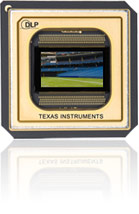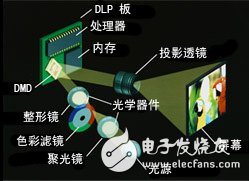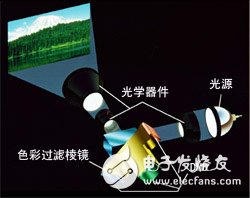1. Continuous improvement of projection semiconductors

The core of every DLP® projection system is an optical semiconductor called a DLP® chip, which was invented by Dr. Larry Hornbeck of Texas Instruments (TI) in 1987.
The DLP chip may be the most precise optical switch in the world. It contains a matrix of up to 2 million micromirrors mounted on hinges; each micromirror is less than one-fifth the size of a human hair.
When the DLP chip is coordinated with digital video or graphic signals, the light source micromirror and projection lens can reflect the digital image to the screen or other surface. The DLP chip combined with the advanced electronic components around it can produce stunning images and videos that redefine the picture quality.
2. Grayscale image
The DLP chip's micromirror can be inclined toward the light source (on) or away from the light source (off) in the DLP projection system. This can cause pixels to be bright or dark on the projection surface.

The bitstream image code input to the semiconductor directs each micromirror to switch up and down thousands of times per second. When the number of times the micromirror is opened is more than the number of times closed, light gray pixels will be reflected, and when the number of times the micromirror is closed is more than the number of times open, dark gray pixels will be reflected.
In this way, the micro-mirrors in the DLP projection system can reflect up to 1024 gray-scale gradient pixels, and convert the video or graphic signals entering the DLP chip into very detailed gray-scale images.
3. Add color
The white light generated by the lamps in the DLP projection system passes through the color filter as it travels to the surface of the DLP chip. This function can filter at least red, green and blue light, from which a single-chip DLP projection system can generate at least 16.7 million colors.
BrilliantColor â„¢ technology can add other colors (including cyan, magenta and yellow) to enrich the color palette and achieve a richer color expression. Some DLP projectors provide solid-state lighting that can replace traditional white lights. Therefore, the light source can emit the necessary colors to avoid the use of color filters. The 3-chip architecture is used in some DLP systems and is particularly suitable for high-brightness projectors required for large venue applications such as concerts and movie theaters. These systems are capable of producing more than 35 trillion colors.
The switching state of each micromirror is coordinated with these basic color building blocks. For example, the micromirror responsible for projecting purple pixels will only reflect red and blue light to the projection surface; these colors will then be mixed to see the expected colors in the projected image.
4. Application and configuration
Single chip DLP projection system
Many data projectors and HDTVs that use DLP technology rely on the single-chip configuration described above.

White light passes through the color filter, causing the surface of the DLP chip to appear red, green, blue, and even other primary colors in sequence (such as yellow, cyan, magenta, etc.). The switches of the lenses and the proportion of time they are "on" or "off" are coordinated according to the color illuminated on them. Then, the sequential colors will be mixed to produce the full-color image you see on the screen.
3 chip DLP projection system
Projectors using DLP technology and large venue projectors suitable for ultra-high brightness applications (such as movies) rely on a 3-chip configuration to produce stunning images, whether static or dynamic.

In the 3-chip system, the white light generated by the lamp will be separated into red, green and blue by the prism. Each DLP chip is dedicated to identifying one of these three colors; the colored light reflected by the micromirrors will then be combined and passed through the projection lens to form an image.
Regardless of application or design, projectors using DLP technology will continue to improve the standards of picture quality and video performance. Its starting point is a small imaging chip, which consists of millions of micromirrors called DLP that can produce wonderful pictures.
Some client may feel that 10th Laptop is little old, so prefer 11th Laptop or 12th laptop. However, you will the 10th cpu is even more powerful than 11th, but price is nearly no difference, especially you take in lot, like 1000pcs. As a professional manufacturing store, you can see Laptop i3 10th generation 8gb ram,i5 laptop 10th generation, intel i7 10th gen laptop, etc. It`s a really tough job selecting a right one on the too many choices. Here are some tips, hope help you do that easier. Firstly, ask yourself what jobs you mainly need this Gaming Laptop to do. Secondly, what special features you care more? Like fingerprint, backlight keyboard, webcam rj45, bigger battery, large screen, video graphics, etc. Finally, ask the budget you plan to buy gaming laptop. Thus you will get the idea which laptop is right one for you.
Except integrated laptop, also have graphic laptop with 2gb or 4gb video graphic, so you can feel freely to contact us anytime and share your basic requirements, like size, cpu, ram, rom, video graphics, quantity,etc. More detailed value information provided in 1-2 working days for you.
10th Laptop,Laptop I3 10th Generation 8gb Ram,I5 Laptop 10th Generation,10th Generation Laptop,Intel I7 10th Gen Laptop
Henan Shuyi Electronics Co., Ltd. , https://www.shuyioemelectronics.com
